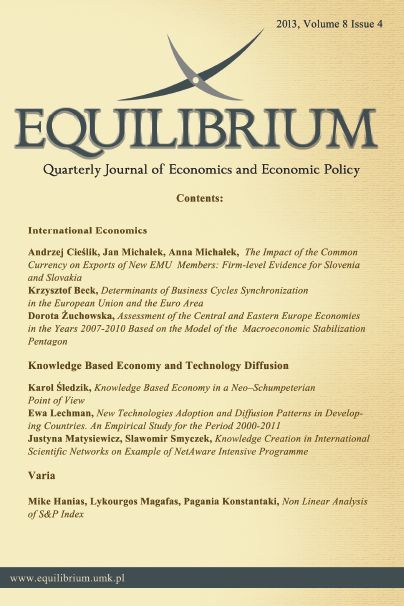Non Linear Analysis of S&P Index
DOI:
https://doi.org/10.12775/EQUIL.2013.030Keywords:
exchange rates, time series, chaos theoryAbstract
This paper applies non-linear methods to analyze and predict the daily open S&P index which is one of the most important stock index in the world. The aim of the analysis is to quantitatively show if the corresponding time series is a deterministic chaotic one and if one or more days ahead prediction can be achieved. These results make the present work a valuable tool for traders investors and funds.
Downloads
References
Alexander C. (2002), Market models, John Wiley&Sons Ltd., New York.
Alexander C., Giblin I. (1997), Multivariate embedding methods: Forecasting highfrequency data in the INFFC, ?Journal of Computational Intelligence in Finance? Vol. 5 No. 6.
Coronnello C.M., Tumminello F.L., Micciche S. Mantegna R.N. (2007), Economic Sector Identification in a Set of Stocks Traded at the New York Stock Exchange: A Comparative Analysis, ?Noise and Stochastics in Complex Systems and Finance?, Vol. 6601.
Garas A., Argyrakis P. (2007), Correlation Study of the Athens Stock Exchange, ?Physica?, Vol. 380.
Grassberger P., Procaccia I. ( 1983a), Estimation of the kolmogorov entropy from a chaotic signal, ?Physical Review?, Vol. 28, No. 4. Grassberger P., Procaccia I. (1983b), Measuring the strangeness of strange attractors, ?Physica?, Vol. 9.
Hanias M.P., Giannaris G., Spyridakis A., Rigas A. (2006), Time series analysis in chaotic diode resonator circuit, ?Chaos Solitons and Fractals?, Vol. 27, No. 2.
Hanias M.P., Magafas L. (2012), DemoscopoPhysics: A New and Interdisciplinary Research Field, ?Chaos and Complexity Theory for Management: Nonlinear Dynamics?, Vol. 16.
Hanias M.P., Curtis G., Thallasinos J.E. (2007), Non-linear dynamics and chaos: The case of the price indicator at the Athens Stock Exchange, ?International Research Journal of Finance and Economics?, Vol. 11.
Hanias M.P., Curtis G., Ozun A. (2008), Chaos theory in predicting the Istanbul Stock Exchange Index, ?Empirical Economics Letters?, Vol. 7, No. 4.
Hanias M.P., Curtis P.G (2008), Time Series Prediction of Dollar\Euro Exchange Rate Index, ?International Research Journal of Finance and Economics?, Vol. 15.
Kantz H., Schreiber T. (1997), Nonlinear Time Series Analysis, Cambridge University Press, Cambridge.
Kodba S., Perc M., Marhl M. (2005), Detecting Chaos from a Time Series, ?European Journal of Physics?, Vol. 26.
Ott E., Sauer T., Yorke J.A. (1994), Coping with chaos, Wiley ? Interscience Publication, New York.
Ozun A, Hanias M.P., Curtis P.G. (2010), A chaos analysis for Greek and Turkish equity markets, ?EuroMed Journal of Business?, Vol. 5, No. 1.
Peters E.E. (1991), Chaos and order in the capital markets, Wiley Finance Editions, New York.
Schouten J.C., Takens F., Bleek C.M. (1994), Estimation of the Dimension of a Noisy Attractor, ?Physics Review?, Vol. 50, No. 3.
Sprott J.C. (2003), Chaos and Time series Analysis, Oxford University Press.
Sugihara G., May R.M. (1990), Nonlinear forecasting as a way of distinguishing chaos from measurement error in time series, ?Nature?, Vol. 344.
Takens F. (1981), Detecting strange attractors in turbulence [in:] Rand D. Young L.-S. (eds.), Dynamical Systems and Turbulence, Lecture Notes in Mathematics, Warwick.






